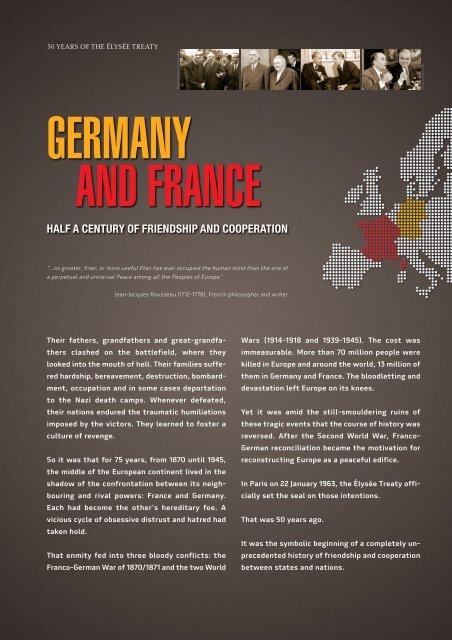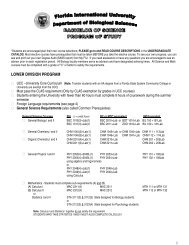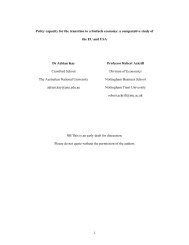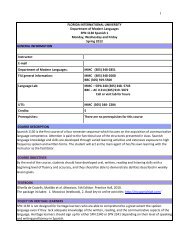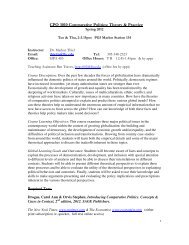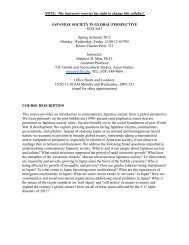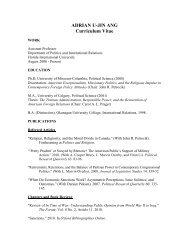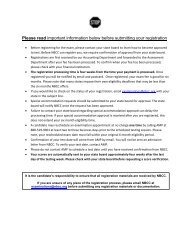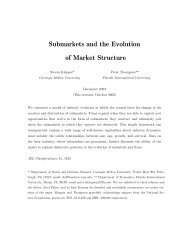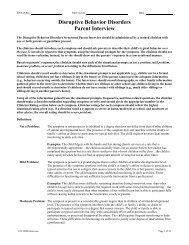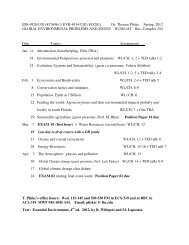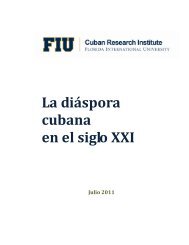GERMANY AS A
GERMANY AS A
GERMANY AS A
Create successful ePaper yourself
Turn your PDF publications into a flip-book with our unique Google optimized e-Paper software.
50 YEARS OF THE ÉLYSÉE TREATY<br />
<strong>GERMANY</strong><br />
AND FRANCE<br />
HALF A CENTURY OF FRIENDSHIP AND COOPERATION<br />
“…no greater, finer, or more useful Plan has ever occupied the human mind than the one of<br />
a perpetual and universal Peace among all the Peoples of Europe.”<br />
Jean-Jacques Rousseau (1712-1778), French philosopher and writer<br />
Their fathers, grandfathers and great-grandfa-<br />
thers clashed on the battlefield, where they<br />
looked into the mouth of hell. Their families suffe-<br />
red hardship, bereavement, destruction, bombard-<br />
ment, occupation and in some cases deportation<br />
to the Nazi death camps. Whenever defeated,<br />
their nations endured the traumatic humiliations<br />
imposed by the victors. They learned to foster a<br />
culture of revenge.<br />
So it was that for 75 years, from 1870 until 1945,<br />
the middle of the European continent lived in the<br />
shadow of the confrontation between its neigh-<br />
bouring and rival powers: France and Germany.<br />
Each had become the other’s hereditary foe. A<br />
vicious cycle of obsessive distrust and hatred had<br />
taken hold.<br />
That enmity fed into three bloody conflicts: the<br />
Franco-German War of 1870/1871 and the two World<br />
Wars (1914-1918 and 1939-1945). The cost was<br />
immeasurable. More than 70 million people were<br />
killed in Europe and around the world, 13 million of<br />
them in Germany and France. The bloodletting and<br />
devastation left Europe on its knees.<br />
Yet it was amid the still-smouldering ruins of<br />
these tragic events that the course of history was<br />
reversed. After the Second World War, Franco-<br />
German reconciliation became the motivation for<br />
reconstructing Europe as a peaceful edifice.<br />
In Paris on 22 January 1963, the Élysée Treaty offi-<br />
cially set the seal on those intentions.<br />
That was 50 years ago.<br />
It was the symbolic beginning of a completely un-<br />
precedented history of friendship and cooperation<br />
between states and nations.
© Picture-alliance / dpa<br />
© Picture-alliance / DUMONT Bildarchiv<br />
OPTING<br />
FOR PEACE<br />
Dresden after the bombing (1945), Dresden today<br />
50 YEARS OF THE ÉLYSÉE TREATY<br />
1945-1963<br />
Nazi Germany submitted its unconditional<br />
surrender on 8 May 1945, bringing an end to<br />
the Second World War in Europe. The victo-<br />
rious powers split the demoralized and physically<br />
devastated Germany into four occupation zones. France<br />
was one of those powers and pursued a particularly<br />
tough occupation policy to prevent any resurgence of<br />
German might.<br />
In 1949, the Cold War triggered the partition of<br />
Germany, which was becoming the front line in the<br />
confrontation between East and West. This lent impe-<br />
tus to the Federal Republic’s integration into Western<br />
structures, notably within Europe. On 9 May 1950,<br />
French Foreign Minister Robert Schuman formulated<br />
a proposal that was to lay the foundations of the<br />
future, suggesting that German and French coal and<br />
steel production be placed under a common High<br />
Authority. War between the former enemies was now<br />
physically impossible, and the process of European<br />
integration had begun.<br />
Alongside these developments, a number of forward-<br />
looking thinkers were forming the building blocks of<br />
rapprochement between the societies of France and<br />
Germany. As early as 1945, these pioneers had unders-<br />
tood that peace would come as a result of better<br />
mutual understanding and the well-supported esta-<br />
blishment of a democratic Germany. Their activities<br />
increased throughout the 1950s, with meetings, joint<br />
publications and town twinnings helping to spread the<br />
spirit of mediation.<br />
That rapprochement started to turn into reconciliation<br />
as of 1958, under the influence of General de Gaulle<br />
and Chancellor Konrad Adenauer. A genuine friendship<br />
developed between the one-time Resistance leader<br />
who had become President of the French Republic and<br />
the Christian-Democrat, pro-European Chancellor with<br />
an anti-Nazi past. The two sides’ interests did the rest. On<br />
22 January 1963, France and Germany signed the Élysée<br />
Treaty, putting the official seal on the reconciliation.
50 YEARS OF THE ÉLYSÉE TREATY<br />
CONSIGNING HATE TO THE P<strong>AS</strong>T<br />
PIONEERS AND PEACE-MAKERS<br />
To begin with, there were no more than a handful of<br />
them. Intellectuals, journalists, writers, civil servants,<br />
trade unionists, clergymen or youth workers, many had<br />
a background in religion, both Catholic and Protestant,<br />
or in Resistance circles. Some were former soldiers,<br />
concentration camp inmates or prisoners of war.<br />
From 1945 and right on through the 1950s, these<br />
individuals worked to bring German and French people<br />
closer together. Their ideas may not have had a direct<br />
impact on politics, but they helped gradually change<br />
prevalent mindsets.<br />
Franco-German rapprochement thus took root in civil<br />
society after the Second World War before gaining a<br />
political dimension.<br />
THE ADVENT OF TOWN TWINNING:<br />
RECONCILIATION FROM THE BOTTOM UP<br />
In 1950, Montbéliard and Ludwigsburg became the first<br />
Franco-German pair of towns to be twinned. It took<br />
courage to enact this plan only five years after the war,<br />
but as Montbéliard’s Mayor Lucien Tharradin put it,<br />
“You can’t build anything on hate.” “Who will still dare<br />
to deny that we need to make peace with one another?<br />
To live with our fingers permanently poised on our<br />
triggers, ready to engulf the world in flames, is no way<br />
for two nations to exist.”<br />
JOSEPH ROVAN<br />
“THE <strong>GERMANY</strong> THAT WE DESERVE”<br />
“The more our enemies have disfigured the face of<br />
humanity, the more we must respect it, even embellish<br />
it, in them. […] Tomorrow’s Germany will reflect what<br />
we have been worthy of.”<br />
Joseph Rovan, former concentration camp inmate<br />
Translated extract from an article published in French magazine Esprit<br />
on 1 October 1945, when France was pursuing its very tough occupation<br />
policy in Germany<br />
“Invalides”, a caricature by<br />
Bertall on the Franco-German<br />
War of 1870/1871, published<br />
in the satirical magazine Le<br />
Grelot on 13 August 1871.<br />
ALFRED GROSSER<br />
IS IT RIGHT TO SPEAK OF “RECONCILIATION”?<br />
According to Professor Alfred Grosser, political scientist, historian,<br />
sociologist and pioneer of Franco-German rapprochement,<br />
“Franco-German rapprochement made sense with respect to<br />
the war of 1914-1918. That conflict was a clash between two<br />
nations.” In contrast, 1945 was the triumph of free peoples over<br />
the Nazi regime. “There was certainly no call for reconciliation<br />
with Germans whom Hitler had imprisoned; once Nazism had<br />
been defeated, what we wanted was to work with them to make<br />
a post-war Germany they could identify with.”<br />
Professor Alfred Grosser (born in 1925)<br />
© Picture-alliance / Sven Simon © Picture-alliance / akg-images
50 YEARS OF THE ÉLYSÉE TREATY<br />
EUROPE – BOUND TOGETHER BY<br />
A COMMON DESTINY<br />
Throughout the 1950s, Franco-German reconciliation<br />
was synonymous with European integration, which<br />
germinated as the Cold War took hold.<br />
It all started in 1950 with an incredibly bold proposition<br />
– to pool mining and steel production. This was a<br />
move that would effectively preclude any prospect of<br />
Franco-German war. Couched in the idea of federalization,<br />
the project came out of Jean Monnet’s reflections on<br />
the future of Europe. In 1951, the European Coal and<br />
Steel Community (ECSC) laid the foundation stone of<br />
European integration.<br />
With France and Germany forming the core, Belgium,<br />
Luxembourg, the Netherlands and Italy gathered<br />
around them. These six signed the Treaties of Rome on<br />
25 March 1957 to establish the European Economic<br />
Community (EEC) and Euratom. The EEC created a<br />
common market in which goods could circulate freely.<br />
Europe was making tangible progress. The issue of its<br />
political architecture, however, remained unresolved.<br />
France put forward a proposal for political union in<br />
1960, but it was not taken up.<br />
The Treaties of Rome were signed on 25 March 1957.<br />
© Picture-alliance / akg-images<br />
Konrad Adenauer (l.), Robert Schuman, Alcide De Gasperi (r.)<br />
THE FOUNDING ACT:<br />
THE SCHUMAN DECLARATION<br />
“Europe will not be made all at once, or according to a<br />
single plan. It will be built through concrete achieve-<br />
ments which first create a de facto solidarity. The<br />
coming together of the nations of Europe requires the<br />
elimination of the age-old opposition of France and<br />
Germany. […]<br />
With this aim in view, the French Government proposes<br />
that action be taken immediately […] It proposes that<br />
Franco-German production of coal and steel as a whole<br />
be placed under a common High Authority, within the<br />
framework of an organization open to the participation<br />
of the other countries of Europe.<br />
[…] The solidarity in production thus established<br />
will make it plain that any war between France and<br />
Germany becomes not merely unthinkable, but materia ly<br />
impossible.”<br />
Declaration by Robert Schuman,<br />
French Foreign Minister, 9 May 1950<br />
© Picture-alliance / dpa
General de Gaulle’s speech to the youth of Germany<br />
in Ludwigsburg, September 1962<br />
DE GAULLE’S PRAISE FOR<br />
<strong>GERMANY</strong> <strong>AS</strong> A “GREAT NATION”<br />
In the course of his official visit to Germany from<br />
4 to 9 September 1962, General de Gaulle, the<br />
personification of France’s anti-Nazi Resistance,<br />
honoured the Germans as a “great nation”, mostly<br />
speaking German when he did so. He reaped delighted<br />
applause from the crowds.<br />
“I furthermore congratulate you on being young<br />
Germans, on being the children of a great nation.<br />
Yes, a great nation – which has at times, during the<br />
course of its history, committed grave errors. But a<br />
nation too from which great wealth – intellectual,<br />
scientific, artistic, philosophical – has swept<br />
across the world; a nation which has enriched us all<br />
with the products of its inventiveness, its techno-<br />
logy, its labour; a nation that has demonstrated,<br />
both in its peacetime endeavours and amid the<br />
suffering of war, deep, rich seams of courage,<br />
discipline and organization.”<br />
50 YEARS OF THE ÉLYSÉE TREATY<br />
TWO VISIONARIES<br />
CHARLES DE GAULLE AND KONRAD ADENAUER<br />
[ ]<br />
A MEETING OF MINDS BETWEEN<br />
TWO MEN AND, THROUGH THEM,<br />
BETWEEN TWO COUNTRIES<br />
Speech to the youth of Germany,<br />
Ludwigsburg, 9 September 1962<br />
© FGYO<br />
© Picture-alliance / dpa © Picture-alliance / Kurt Rohwedder<br />
When General de Gaulle returned to office in 1958, Chancellor<br />
Adenauer at first feared that the President’s strong attachment<br />
to French independence might weaken the fledgling<br />
European project.<br />
Then, on 14 September, de Gaulle invited the German<br />
Chancellor to join him in more intimate surroundings at<br />
his private residence in Colombey-les-deux-Églises. Similar<br />
in their humility and love of culture, the two heads of state<br />
found themselves brought together by mutual respect and<br />
shared convictions. Their interpreter, Hermann Kusterer,<br />
would later describe it as a meeting of minds between two<br />
men and, through them, between two countries.<br />
In 1962, de Gaulle and Adenauer enacted that relationship<br />
during official visits to one another’s countries. They made<br />
symbolic gestures and solemn declarations, from a reconciliation<br />
Mass in Reims Cathedral to de Gaulle’s speech inviting<br />
the “great nation” of Germany to help build Franco-German<br />
friendship and the future of Europe.<br />
It was thanks to this shared political will, along with the<br />
context of the Cold War encouraging westward integration,<br />
and the interests of both sides, that the Élysée Treaty was<br />
signed.<br />
General de Gaulle (l.) and<br />
Chancellor Konrad Adenauer (r.)<br />
Chancellor Adenauer in Reims, 8 July 1962
THE<br />
RECONCILIATION<br />
TREATY<br />
© French Ministry of Foreign Affairs<br />
The Élysée Treaty was signed on 22 January 1963.<br />
50 YEARS OF THE ÉLYSÉE TREATY<br />
1963<br />
General de Gaulle now wanted to perpetuate<br />
the solemn, sacred reconciliation he and<br />
Chancellor Adenauer had pledged in Reims<br />
and Germany in 1962. On 22 January 1963, they<br />
signed a treaty of friendship and cooperation in Paris,<br />
in the Salon Murat of the Élysée Palace. This set the<br />
seal on the reconciliation process; it provided a<br />
concrete base on which France and Germany could<br />
develop their friendly, cooperative relations. A joint<br />
declaration issued at the time underlines the<br />
treaty’s historic significance.<br />
In 1963, the Élysée Treaty was not yet the founding<br />
act that it has since become. It was an achieve-<br />
ment, certainly – the fruit of years of effort to bring<br />
the two societies closer together and, above all, of<br />
the political will voiced by de Gaulle and Adenauer.<br />
Nonetheless, it was for the most part a product of<br />
the circumstances and interests of its time.<br />
For Germany, the building of the Berlin Wall in<br />
August 1961 had galvanized support for partnership<br />
with France.<br />
For France, the failure of de Gaulle’s Fouchet Plan<br />
for political union in early 1962 became an incentive<br />
to try and do with Germany alone what had proved<br />
impossible to achieve with all six EEC states.<br />
Now considered the keystone of all Franco-German<br />
cooperation, the treaty at first looked set to be<br />
forgotten. It would be some years before the mecha-<br />
nisms it established started to wield their powerful<br />
effect at a level beyond temporary circumstance.
© Federal Foreign Office<br />
In a joint declaration to accompany the treaty,<br />
Adenauer and de Gaulle highlighted the status of<br />
Franco-German reconciliation as “a historic event<br />
which profoundly transforms the relations between<br />
the two peoples”.<br />
They added that “increased cooperation between the<br />
two countries constitutes an indispensable stage on<br />
the way to a united Europe, which is the aim of the<br />
two peoples”.<br />
The treaty established how Franco-German cooperation<br />
was to be organized, particularly by enshrining<br />
an obligation for regular political coordination. It<br />
covered the three areas of foreign affairs, defence,<br />
and education and young people. Economic relations<br />
and cultural affairs, which had been at the heart of<br />
previous bilateral and European agreements, were<br />
not mentioned.<br />
The Élysée Treaty<br />
50 YEARS OF THE ÉLYSÉE TREATY<br />
FRIENDSHIP AND COOPERATION –<br />
OPERATING INSTRUCTIONS<br />
Chancellor Adenauer (l.) and General de Gaulle (r.) signed the Élysée Treaty<br />
in Paris on 22 January 1963.<br />
THE SUBSTANCE OF THE<br />
TREATY – MORE A METHOD<br />
THAN A SET OF GOALS<br />
Next to giving the two countries’ young people a central role by<br />
enshrining the idea of exchanges, the treaty principally served<br />
to institute regular consultation between Paris and Bonn (later<br />
Berlin). It set schedules for meetings at various levels:<br />
• The heads of state and government were to meet whenever<br />
required and in principle at least twice a year.<br />
• The foreign ministers were to meet at least once every three<br />
months.<br />
• Alternating between Bonn and Paris, monthly meetings were<br />
to be held for high-level political, economic and cultural affairs<br />
officials from the two foreign ministries to review current<br />
issues and prepare the ministerial meetings. The embassies<br />
and consulates would furthermore set up all the necessary<br />
contacts for addressing issues which affected both countries.<br />
• The defence ministers were to meet at least once every<br />
three months, as were those responsible for education and<br />
cultural policy.<br />
• Meetings between the army chiefs of staff were to be held<br />
at least once every two months.<br />
• Those responsible for policy on youth and family affairs were<br />
to meet at least once every two months.<br />
The treaty also provided for this cooperation to be evaluated<br />
on a regular basis.<br />
© Picture-alliance / united archives
50 YEARS OF THE ÉLYSÉE TREATY<br />
YOUTHFUL ENERGY<br />
TO DRIVE NEW GROWTH<br />
The declaration attached to the treaty called<br />
on young people to play “a decisive role in the<br />
consolidation of Franco-German friendship”.<br />
The hope was that younger generations,<br />
people who had not lived through those three<br />
fratricidal wars, would lead the way in building<br />
the new Franco-German relationship.<br />
[ ]<br />
THE TREATY CALLED ON YOUNG PEOPLE<br />
TO PLAY “A DECISIVE ROLE IN THE<br />
CONSOLIDATION OF FRANCO-GERMAN<br />
FRIENDSHIP”<br />
A youth camp organized by the Franco-German Youth Office (FGYO) in 1964<br />
© FGYO<br />
Young German and French cyclists meeting under the auspices of a town twinning<br />
programme in the 1960s<br />
© FGYO<br />
This was to be achieved by having young<br />
people meet, speak to each other and<br />
come to appreciate one another, investing<br />
time and energy in shared activities. So it<br />
was that, on the back of the Élysée Treaty,<br />
the Franco-German Youth Office (FGYO)<br />
was created on 5 July 1963.<br />
But would meetings alone be enough?<br />
The initial project certainly turned out to<br />
have been somewhat idealistic. It was<br />
quickly improved, however, thanks to<br />
thorough-going review of its educational<br />
ideas. Active, inventive and committed, the<br />
FGYO little by little developed innovative<br />
strategies and tools for encouraging<br />
exchange between French and German<br />
children, adolescents, school pupils, students<br />
and young professionals. To date, it<br />
has enabled more than eight million young<br />
people from France and Germany to get to<br />
know each other.
© Picture-alliance / dpa<br />
50 YEARS OF THE ÉLYSÉE TREATY<br />
A NEW BEGINNING?<br />
At first, the Élysée Treaty did not spark any new<br />
progress.<br />
When the act to ratify it was put to the vote in the<br />
German Bundestag on 15 June 1963, the Members<br />
included a preamble reaffirming that the Federal<br />
Republic of Germany’s goals remained unchanged,<br />
especially that of maintaining “the close partnership<br />
between Europe and the United States of America”.<br />
De Gaulle had just reiterated his independence<br />
vis-à-vis Washington, notably on the subject of UK<br />
membership of the EEC – so he was sorely disappointed.<br />
In a moment of pique, he said, “Treaties are like roses<br />
and young girls – they last while they last.”<br />
Chancellor Adenauer, now aged 87, was replaced in<br />
October 1963 by Ludwig Erhard. Paris and Bonn diverged<br />
on whether Europe would ideally be an intergovernmental<br />
or a supranational structure. The European<br />
project had come to a standstill. The meetings<br />
laid down by the treaty carried on being held, but its<br />
ambitions for foreign policy and defence evaporated.<br />
The German Bundestag voted on 15 June 1963 to pass the act ratifying<br />
the Élysée Treaty. The Members also approved the addition of a preamble.<br />
© Picture-alliance / dpa<br />
General de Gaulle (l.) and Chancellor Ludwig Erhard (r.)<br />
in Bonn on 21 July 1966<br />
OF TREATIES<br />
AND ROSES<br />
Chancellor Adenauer had a response to General<br />
de Gaulle’s annoyance at the preamble Germany<br />
had added to its ratification act:<br />
“[…] I know my stuff when it comes to roses.<br />
The hardiest ones are those with the most<br />
thorns. This friendship between France and<br />
Germany is like a rose bush that will always<br />
produce new buds and bloom again. […] If it<br />
weren’t for that friendship, any attempt to<br />
create this Europe would be doomed from the<br />
start.”<br />
“You are quite right, Chancellor,” replied de<br />
Gaulle. "Our treaty is not a rose, nor even a<br />
rose bush, but a rose garden. A single rose<br />
soon wilts – but a rose garden, if tended well,<br />
can last forever.”
© Picture-alliance / dpa<br />
50 YEARS OF THE ÉLYSÉE TREATY<br />
AN ENGINE TO<br />
DRIVE EUROPE<br />
FORWARDS<br />
1969-1989<br />
President François Mitterrand (l.) and Chancellor Helmut Kohl (r.)<br />
Franco-German cooperation got back under<br />
way in 1969 with President Pompidou and<br />
Chancellor Brandt. The principle of regular<br />
coordination began proving its worth, with the two<br />
leaders getting to know one another, coming to<br />
understand one another and starting to anticipate<br />
one another’s opinions.<br />
It was in 1974, when President Giscard d’Estaing and<br />
Chancellor Schmidt took the reins, that the method<br />
really came into its own. Both were former finance<br />
ministers, they were friends, and they shared the<br />
same assessment of the monetary problems that<br />
were assailing the world at the time. They worked<br />
out joint solutions together, laying the foundations<br />
of future European monetary union. Europe moved<br />
forward step by step. To take one example, the<br />
European Council came to mirror at the European<br />
level what these two leaders had been maintaining<br />
bilaterally.<br />
Europe’s Franco-German “engine” was born.<br />
While the faces changed, the driving force remained<br />
the same. In 1983, President Mitterrand travelled<br />
to the Bundestag to express his solidarity with<br />
Germany in the face of the Soviet Euromissiles. It<br />
was a gesture that Chancellor Kohl would not forget.<br />
Linked by their love of history and their tragic expe-<br />
rience of the war, the two men were committed to<br />
building a peaceful Europe together. The Franco-<br />
German engine was in top gear, and Europe moved full<br />
steam ahead, from the abolition of physical borders<br />
and trade barriers to the creation of the European<br />
Union (EU) and the euro.<br />
Pompidou the Gaullist and Brandt of the Social<br />
Democrats; the Centrist Giscard d’Estaing and the<br />
Social Democrat Schmidt; Mitterrand the Socialist<br />
and Kohl of the Christian Democrats – together, they<br />
proved how little the Franco-German tandem relied<br />
on party-political allegiance for its success.
© Picture-alliance / dpa<br />
50 YEARS OF THE ÉLYSÉE TREATY<br />
MÉNAGE À DEUX<br />
The 1970s saw international economic problems multiply:<br />
the Bretton Woods monetary system disintegrated,<br />
replaced by floating exchange rates, while the<br />
world was shaken by oil shocks, economic crisis and<br />
rising unemployment.<br />
In the face of these difficulties, Germany’s Chancellor<br />
Helmut Schmidt and France’s President Valéry Giscard<br />
d’Estaing formed an effective, youthful tandem with a<br />
more pared-down, modern style. That is not to say that<br />
Germany and France always agreed – but their<br />
constant dialogue made progress possible.<br />
Hélène Miard-Delacroix, professor and Franco-German<br />
relations expert at the Sorbonne, writes, “This was one<br />
of those phases in Franco-German political relations<br />
during which the constraints imposed by the Élysée<br />
Treaty were superfluous”.<br />
The “Abibac” was instituted as a Franco-German combined higher<br />
education entrance qualification.<br />
The years 1970-1980 saw the election of a European<br />
Parliament by universal suffrage and the<br />
creation of the European Space Agency (ESA) as<br />
well as Franco-German schools and a Franco-<br />
German baccalaureate.<br />
Franco-German coordination spread from the bilateral<br />
to the European level and onto the world stage. Valéry<br />
Giscard d’Estaing and Helmut Schmidt helped create<br />
the G7 to bring together the world’s most industrialized<br />
countries, as well as the European Council, which<br />
would ensure regular meetings for Europe’s heads of<br />
state and government.<br />
President Valéry Giscard d’Estaing (l.) and Chancellor Helmut Schmidt (r.)<br />
The “snake in the tunnel” currency band of 1972 and<br />
the European Exchange Rate Mechanism (ERM) that<br />
followed in 1978 made it possible to stabilize the<br />
currencies of Europe. These were the foundations of<br />
the future European monetary union.<br />
The European Parliament has been elected by universal suffrage since 1979.<br />
© Picture-alliance / dpa<br />
© Picture-alliance / dpa
50 YEARS OF THE ÉLYSÉE TREATY<br />
A FRESH BOOST FOR THE EUROPEAN<br />
PROJECT<br />
President François Mitterrand and Chancellor<br />
Helmut Kohl made history with a hugely powerful<br />
gesture of peace on 22 September 1984. At<br />
Verdun, a battlefield soaked in the blood of<br />
German and French combatants in the First<br />
World War, they reached out over the graves to<br />
shake hands in reconciliation.<br />
Uniting two fervent Europeans, the Franco-<br />
German tandem gave Europe fresh impetus,<br />
working in close liaison with the President of the<br />
European Commission, Jacques Delors.<br />
President François Mitterrand (l.) and Chancellor Helmut Kohl (r.) paid homage<br />
together at Verdun, among the graves of French and German soldiers killed in the<br />
First World War, on 22 September 1984.<br />
© Picture-alliance / dpa<br />
Thanks to the Single European Act, people, goods, services and capital can<br />
circulate throughout the territory of the community as freely as they can<br />
within any one country, national borders no longer an obstacle.<br />
© Frédéric de La Mure / French Ministry of Foreign Affairs<br />
[ ]<br />
AN AREA WITHOUT INTERNAL<br />
FRONTIERS IN WHICH THE FREE<br />
MOVEMENT OF GOODS, PERSONS,<br />
SERVICES AND CAPITAL IS ENSURED<br />
These efforts culminated in the Single<br />
European Act signed in 1986. This ambitious<br />
treaty changed the rules of how the European<br />
institutions worked and gave more<br />
powers to the European level so that<br />
the internal market could be completed.<br />
1 January 1993 saw the birth of the single<br />
European market, “an area without internal<br />
frontiers in which the free movement of<br />
goods, persons, services and capital is<br />
ensured”.<br />
Having in 1983 become the first leader to<br />
invoke the Élysée Treaty, François Mitterrand<br />
was at Helmut Kohl’s side to celebrate<br />
its 25th anniversary in 1988.
© Picture-alliance / JOKER<br />
EUROPE IN MICROCOSM<br />
The cooperation that France and Germany were enjoying was open to other countries in Europe and was in many<br />
areas something of a testing ground for the European project, the microcosm at the centre of much broader<br />
collaboration.<br />
AEROSPACE<br />
AIRBUS<br />
Established in 1970, Airbus Industrie started out as a Franco-<br />
German industrial consortium. Opened up to the Spanish in<br />
1971 and the British in 1979, it has been part of the EADS<br />
group since 2006. EADS, or the European Aeronautic Defence<br />
and Space Company, was formed from the merger of France’s<br />
Aérospatiale Matra, Germany’s DaimlerChrysler Aerospace AG<br />
(D<strong>AS</strong>A) and Spain’s C<strong>AS</strong>A. It is a global giant in the production<br />
of civil helicopters (Eurocopter), commercial aircraft (Airbus)<br />
and space-industry technology (Astrium).<br />
ARTE headquarters in Strasbourg<br />
DEFENCE<br />
THE FRANCO-GERMAN BRIGADE<br />
50 YEARS OF THE ÉLYSÉE TREATY<br />
Formed in 1989, the Franco-German Brigade were pioneers of<br />
European defence. Under the operational control of Eurocorps<br />
since 1993, the Brigade today comprises 5,000 servicemen<br />
and -women from France and Germany and has undertaken<br />
operations abroad in Bosnia (1997) and Afghanistan (2005). Its<br />
history is full of symbols of rediscovered peace. In 1994, the<br />
Brigade paraded along the Champs-Élysée on Bastille Day; in<br />
2010, it saw the first German battalion stationed on French<br />
soil since the end of the Second World War.<br />
TELEVISION<br />
ARTE<br />
The idea of a Franco-German public TV channel, broadcasting<br />
for Europe, germinated in the late 1980s. ARTE today broad-<br />
casts programmes in multiple languages from its base in<br />
Strasbourg to every corner of Europe. A regular feature is<br />
“Karambolage”, a programme shown every Sunday at 9.30 p.m.<br />
which takes a humorous look at the cultural and linguistic<br />
differences between the French and Germans.<br />
The Airbus A 380<br />
The Franco-German Brigade<br />
© Picture-alliance / Oliver Berg<br />
© Picture-alliance / dpa
50 YEARS OF THE ÉLYSÉE TREATY<br />
A NEW BALANCE<br />
AND NEW<br />
CHALLENGES<br />
© Picture-alliance / dpa<br />
since 1990<br />
The fall of the Berlin Wall, 9 November 1989<br />
On 9 November 1989, the world order was hit<br />
by the bombshell of the fall of the Berlin<br />
Wall. The end of East-West confrontation<br />
produced a long string of consequences, from German<br />
unification in 1990 to the unification of Europe in<br />
2004. A new, multipolar world emerged.<br />
Reunification created a new situation for the Franco-<br />
German tandem: economically, demographically and<br />
politically, the balance had changed, and Germany<br />
had shifted geographically towards the middle of<br />
Europe. The joint response to these changes was to<br />
be a leap forward for Europe.<br />
This visionary approach, however, could not dispel<br />
all fears and tensions. At the turn of the 21st cen-<br />
tury, the Franco-German engine found itself unable<br />
to reach compromise on how the enlarged EU should<br />
function, to say nothing of their discreetly avoided<br />
differences of opinion on the euro.<br />
Nevertheless, the Franco-German reflex was<br />
still there. In 2003, President Jacques Chirac and<br />
Chancellor Gerhard Schröder instigated tangible<br />
steps to breathe new life into the Élysée Treaty on its<br />
40th anniversary – to reinforce intergovernmental<br />
cooperation, institute a Franco-German Day for<br />
schools and encourage people in each country to<br />
learn the other’s language.<br />
From 2007 on, the first tandem of the post-war era<br />
was inhabited by Chancellor Angela Merkel and<br />
President Nicolas Sarkozy. Together, they faced the<br />
global financial crisis, then the crisis in the eurozone,<br />
and worked to correct the latter’s structural flaws.<br />
Since 2012, the Chancellor has been continuing<br />
those efforts alongside President François Hollande.
Following the fall of the Berlin Wall, Germany was<br />
unified on 3 October 1990.<br />
France watched the events unfolding next door with<br />
interest. As a legal legacy of the war, it still held a<br />
political responsibility towards Germany. French<br />
President François Mitterrand supported reunification<br />
under the leadership of Chancellor Kohl, and so did the<br />
French public, though some quarters of the French<br />
media expressed reservations.<br />
50 YEARS OF THE ÉLYSÉE TREATY<br />
A NEW <strong>GERMANY</strong><br />
Paris and Bonn shared a desire to link German reunifi-<br />
cation with further European integration. This process<br />
led to qualitative progress in two regards: comprehen-<br />
sive reform of the European institutions, which led to<br />
the birth of the European Union (EU), and the creation of<br />
an Economic and Monetary Union (EMU) with a common<br />
currency. These advances are enshrined in the Treaty<br />
of Maastricht, which entered into force in 1993.<br />
The fall of the Berlin Wall enabled Germany’s democratic reunification.<br />
© Picture-alliance / dpa<br />
[ ]<br />
© Picture-alliance / dpa<br />
GERMAN REUNIFICATION LED<br />
TO M<strong>AS</strong>SIVE REFORM OF<br />
THE EUROPEAN INSTITUTIONS<br />
The Maastricht Treaty established the European Union (EU).<br />
FRANÇOIS MITTERRAND<br />
AND GERMAN UNIFICATION<br />
“For all that, the Franco-German couple stuck<br />
together. The Chancellor and I had similar views<br />
on constructing Europe and took that ambition<br />
as the touchstone of everything we did.”<br />
François Mitterrand,<br />
De l'Allemagne. De la France, 1996
© Picture-alliance / dpa<br />
50 YEARS OF THE ÉLYSÉE TREATY<br />
UNIFYING EUROPE<br />
Chancellor Kohl repeatedly said that German and<br />
European unity were “two sides of the same coin”.<br />
In the wake of German unification, the countries of<br />
East Central Europe, now freed from the Soviet yoke,<br />
sought to join the European Union, which accepted<br />
this legitimate desire.<br />
Faced with a choice between deepening and expanding<br />
European integration, the EU decided to push ahead<br />
with both. This was an immense task. The nascent<br />
democracies of Eastern Europe had a considerable<br />
need for economic development. New debates arose:<br />
should the new Europe be moving at several different<br />
speeds? How should the institutional architecture<br />
of the new Europe – now doubled in size – look?<br />
Faced with these challenges, the Franco-German<br />
engine stalled. Disagreements culminated at the<br />
negotiations of the Treaty of Nice in 2000. Europe was<br />
in stalemate. This untenable situation called for a topdown<br />
solution, and the project of drafting a European<br />
constitution began. Paris and Berlin took the 40th<br />
anniversary of the signing of the Élysée Treaty as an<br />
occasion to demonstrate reinvigorated cooperation.<br />
Former foreign ministers of Poland, Germany and France,<br />
Krzysztof Skubiszewski, Hans-Dietrich Genscher and Roland Dumas<br />
© Picture-alliance / ZB<br />
THE WEIMAR TRIANGLE<br />
On 1 May 2004, the European Union gained ten new member<br />
states in Central and Eastern Europe.<br />
In May 2004, German and Polish school children planted trees to celebrate<br />
the enlargement of the European Union.<br />
Formed on 29 August 1991, shortly after the opening of the Iron<br />
Curtain, the Weimar Triangle symbolized Germany’s reconciliation<br />
with its eastern and western European neighbours. It was born of<br />
a joint initiative by the German, French and Polish Foreign Ministers<br />
Hans-Dietrich Genscher, Roland Dumas and Krzysztof Skubiszewski,<br />
and aimed to strengthen dialogue among the three countries – not<br />
only at the political level, but also in civil society.<br />
© Picture-alliance / ZB
The euro is in large part a product of Franco-German<br />
cooperation. Ever since the first steps towards a<br />
shared currency were taken in the 1970s, these bilateral<br />
partners have been coordinating their positions in the<br />
interests of Europe as a whole.<br />
The euro arose from the Treaty of Maastricht. It was<br />
created in 1999, one year after the founding of the<br />
bank responsible for issuing it, the European Central<br />
Bank in Frankfurt, Germany. Europeans held euro notes<br />
and coins in their hands for the first time on 1 January<br />
2002. Today, 17 countries use the common currency.<br />
Since 1999 the euro has embodied European stability<br />
and prosperity. By eliminating currency trade and<br />
exchange rate issues, it has facilitated commercial trade.<br />
It has also become an important reserve currency.<br />
© Picture-alliance / dpa<br />
50 YEARS OF THE ÉLYSÉE TREATY<br />
THE EURO: SHARING A CURRENCY<br />
The European Central Bank (ECB) in Frankfurt, Germany<br />
But since 2010 the sovereign debt crisis has compelled<br />
European political leaders to consolidate the Econo-<br />
mic and Monetary Union (EMU). “We have understood<br />
what makes Europe what it is: it is a community which<br />
comes together in shared responsibility”, Chancellor<br />
Angela Merkel has said. It was for this reason that<br />
the eurozone in 2012 created the European Stability<br />
Mechanism (ESM), a permanent rescue package<br />
for future crises. The eurozone also adopted a fiscal<br />
compact envisaging better economic policy coordination<br />
among its members.
From globalization to climate change, financial crises<br />
to security threats, many challenges of the 21st century<br />
have an international dimension. Franco-German coordination<br />
often makes it possible for the two countries<br />
to defend joint positions.<br />
In 2003, for example, Jacques Chirac and Gerhard Schröder<br />
stood apart from other European politicians with their<br />
steadfast refusal to take part in the war in Iraq.<br />
The same year President Chirac spoke on Germany’s<br />
behalf during the European Council, an unprecedented<br />
event. Chancellor Schröder later spoke on France’s behalf<br />
at the United Nations.<br />
Angela Merkel and Nicolas Sarkozy jointly called for<br />
stronger regulation of financial markets at the G20<br />
summit in London, and later at the Copenhagen summit<br />
for a binding international climate change agreement.<br />
In 2012 and 2013, Angela Merkel and François Hollande<br />
are underscoring the significance of Franco-German<br />
reconciliation with joint commemoration of the different<br />
steps in the historical reconciliation process in Reims,<br />
Ludwigsburg and Berlin.<br />
© Picture-alliance / Geisler-Fotopress<br />
50 YEARS OF THE ÉLYSÉE TREATY<br />
A TANDEM IN THE GLOBAL VILLAGE<br />
[ ]<br />
FRANCO-GERMAN COORDINATION OFTEN<br />
MAKES IT POSSIBLE FOR THE TWO<br />
COUNTRIES TO DEFEND JOINT POSITIONS<br />
Thinking about the car of the future is one of the collaborative<br />
projects envisaged by the 2020 Agenda.<br />
In 2003, Paris and Berlin stood shoulder to shoulder to oppose<br />
the war in Iraq.<br />
The Climate Change Conference in Copenhagen, December 2009<br />
AGENDA 2020<br />
In another response to the current problems, France<br />
and Germany adopted the Agenda 2020 in 2010. It<br />
contains 80 proposals for bilateral cooperation to<br />
face future challenges, and is particularly intended<br />
as a model of strong and lasting growth for the<br />
European economy.<br />
© Picture-alliance / dpa © Picture-alliance / dpa
50 YEARS OF THE ÉLYSÉE TREATY<br />
50 YEARS LATER<br />
A MODEL<br />
RELATIONSHIP?<br />
General de Gaulle was right: the Élysée Treaty<br />
was no fleeting blossom, but rather “a rose<br />
garden, [which,] if tended well, can last<br />
forever”. In its fifty years, it has made possible a<br />
degree of cohesion which is unique in the world.<br />
Its first success was highly intensive political coope-<br />
ration. Systematic coordination has established<br />
networks of contacts and formed habits of balancing<br />
different approaches. It has done so at every level,<br />
from heads of state to the lower levels of adminis-<br />
tration. Today there is nothing more ordinary than<br />
holding a Franco-German Council of Ministers, orga-<br />
nizing a Franco-German staff exchange or presen-<br />
ting a joint Franco-German position to the European<br />
Council.<br />
But the French and the Germans often take highly<br />
divergent, or even diametrically opposed, approaches<br />
to issues. Different attitudes are evident when it<br />
comes to nuclear energy, the environment or the<br />
euro. But this is precisely the key to their efficacy:<br />
compelled to deepen their conversation and set<br />
aside their own logic in order to understand the<br />
other’s way of thinking, the French and the Germans<br />
arrive at mutual compromises which then prove<br />
persuasive to many other European partners as well.<br />
The treaty’s major success, however, lies in the<br />
friendship which has arisen between the people of the<br />
two countries thanks to civil society actors and to<br />
ongoing exchanges among young people, researchers,<br />
artists, and the general public of both countries, not<br />
to mention businesses. These ties of friendship<br />
seem self-evident today, but they are the result of<br />
great effort. Every generation must work to keep<br />
nourishing and expanding them.
© Picture-alliance / dpa © Picture-alliance / dpa<br />
EUROPE AT PEACE<br />
The victory of peace over inherited enmity, and the<br />
entrenchment of this peace in European integration, is<br />
undoubtedly the greatest achievement of the Franco-<br />
German tandem.<br />
In 2012, the Nobel Prize Committee honoured this<br />
achievement when it awarded the Nobel Peace Prize to<br />
the European Union. “Today war between Germany and<br />
France is unthinkable. This shows how, through wellaimed<br />
efforts and by building up mutual confidence,<br />
historical enemies can become close partners.”<br />
But no peace is ever final. As President Mitterrand said<br />
to the Bundestag in 1983, “It’s no good invoking peace<br />
like some invisible force; peace needs to be built, and<br />
rebuilt anew every day, shored up and safeguarded. It<br />
needs a cool head and a firm will.”<br />
1 3<br />
2<br />
40th ANNIVERSARY OF THE ÉLYSÉE TREATY<br />
VERSAILLES, 22 JANUARY 2003 (1)<br />
In Versailles, the site of multiple humiliations, the French and<br />
German parliaments assembled jointly for the first time in<br />
history. This was where the German Empire was proclaimed in 1870<br />
after a French defeat, and where the 1919 peace treaty holding<br />
Germany responsible for the First World War, and demanding<br />
massive reparations from it, was signed.<br />
50 YEARS OF THE ÉLYSÉE TREATY<br />
© Picture-alliance / dpa<br />
And so French and German leaders have cultivated a<br />
spirit of reconciliation through symbolic words and<br />
gestures, from the historic handshake at Verdun to the<br />
festivities for the 50th anniversary of the Élysée Treaty.<br />
Since 2006 there has also been a Franco-German<br />
history textbook, written in the hope that pupils could<br />
learn about history in a way that avoids a narrowly<br />
national perspective.<br />
60th ANNIVERSARY OF THE ALLIED LANDINGS IN NORMANDY<br />
CAEN, 6 JUNE 2004 (2)<br />
For the first time, the German Chancellor took part in the<br />
commemoration of the Allied landings that initiated the liberation<br />
of Europe from Nazi rule. “On this day of remembrance and of<br />
hope, the men and women of France welcome you more than<br />
ever as a friend. They welcome you as a brother,” President<br />
Chirac declared. “France has a very different memory of 6 June 1944<br />
than Germany does. And yet these memories have engendered<br />
the same conviction in all of us: we want peace,” Chancellor<br />
Schröder responded.<br />
91st ANNIVERSARY OF THE ARMISTICE ENDING THE FIRST<br />
WORLD WAR<br />
PARIS, 11 NOVEMBER 2009 (3)<br />
Nicolas Sarkozy and Angela Merkel repeated the Verdun hands-<br />
hake 25 years later when they relit the flame of the unknown<br />
soldier beneath the Arc de Triomphe. “We are commemorating not<br />
the victory of one nation over another but a terrible ordeal that<br />
caused suffering on both sides. […] The friendship that exists<br />
between France and Germany is a precious thing” which it is our<br />
task to preserve, President Sarkozy said. “We will never forget<br />
how much the French people suffered at the hands of Germans in<br />
the first half of the 20th century. France has offered Germany the<br />
hand of forgiveness. Germany will never forget that. Germany has<br />
accepted the offer with profound gratitude,” Chancellor Merkel<br />
responded.<br />
[ ]<br />
TODAY WAR BETWEEN<br />
<strong>GERMANY</strong> AND FRANCE<br />
IS UNTHINKABLE
COORDINATION AT ALL LEVELS<br />
The meetings stipulated in the Élysée Treaty have been<br />
continually intensified. The German Chancellor and French<br />
President coordinate with one another frequently at<br />
summits, and hold numerous one-on-one talks. Since<br />
2004 Franco-German Ministerial Councils have been<br />
held twice a year. Since 2010 ministers have had the<br />
option, if invited to do so, of taking part in the partner<br />
country’s cabinet meetings. At all levels, the French and<br />
the Germans speak as openly to one another as they do<br />
within their own respective governments.<br />
The two Commissioners for Franco-German Cooperation,<br />
France’s Bernard Cazeneuve and Germany’s Michael<br />
Link, are charged with making this coordination even<br />
more dynamic. Their work embeds the full scope of<br />
Franco-German cooperation in the European context, as<br />
both of them are also responsible for European affairs<br />
in their respective countries.<br />
There are Franco-German friendship groups in the<br />
French National Assembly, the Senate, the Bundestag<br />
and the Bundesrat. These groups foster close parliamentary<br />
cooperation, including an annual colloquium,<br />
joint sessions of the two foreign affairs committees,<br />
a dialogue among political parties and exchanges<br />
between parliamentary staff.<br />
Rounding out this coordination infrastructure are institutions<br />
such as the Franco-German Defence and Security<br />
Council, the Franco-German Finance and Business<br />
Council, the Franco-German Environment Council and a<br />
Franco-German Culture Council.<br />
THE FRANCO-GERMAN METHOD IN EUROPE<br />
When Franco-German coordination works well, Europe makes progress. When it stalls, Europe grinds to a standstill. The<br />
Franco-German engine alternates between “phases of efficacy and phases of idling”, according to Sorbonne professor<br />
Hélène Miard-Delacroix. In her view, the Franco-German method is comprised of three elements: analyzing the interests<br />
which are indispensable to both sides, identifying the interests and approaches which are only fleeting, and ascertaining<br />
the practical steps to be taken together.<br />
50 YEARS OF THE ÉLYSÉE TREATY<br />
President François Hollande (l.) and Chancellor Angela Merkel (r.)<br />
The French and German foreign ministers, Laurent Fabius (l.)<br />
and Guido Westerwelle (r.)<br />
The Franco-German Ministerial Council meeting at the Federal<br />
Chancellery in Berlin<br />
© Picture-alliance / dpa<br />
© Picture-alliance / dpa<br />
© Picture-alliance / dpa
© Picture-alliance / dpa<br />
BUSINESSES, GOODS AND PEOPLE<br />
THE HUB OF TRANS-EUROPEAN NETWORKS<br />
In communications, energy and transport, the Franco-<br />
German axis is a strategic hub for the development of<br />
trans-European networks. In recent years, for example,<br />
new high-speed rail lines (TGV and ICE) connecting<br />
Paris with Cologne, Munich and Frankfurt have brought<br />
southern, eastern and western Europe closer together.<br />
INVESTMENT: THE TOP SECTORS<br />
THE AUTOMOBILE<br />
INDUSTRY<br />
ELECTRONICS<br />
AND MEDICAL<br />
EQUIPMENT<br />
COMMERCIAL<br />
AND FINANCIAL<br />
SERVICES<br />
TELECOMMUNICATIONS<br />
GERMAN<br />
INVESTMENT<br />
IN FRANCE<br />
50 YEARS OF THE ÉLYSÉE TREATY<br />
BUSINESS SERVICES<br />
THE CHEMICAL,<br />
AUTOMOBILE<br />
AND AERONAUTICS<br />
INDUSTRIES<br />
TRADE<br />
CONSUMER GOODS<br />
LUXURY ITEMS<br />
FRENCH<br />
INVESTMENT<br />
IN <strong>GERMANY</strong><br />
Source : Franco-German Chamber of Commerce and Industry<br />
Situated at the heart of a huge market of 500 million<br />
consumers, Germany and France are the two leading<br />
economies of Europe. They generate half of the<br />
eurozone’s gross domestic product (GDP) and 40% of<br />
the European Union’s GDP. Innumerable trade, industry<br />
and personal ties connect the two countries.<br />
2,900 German businesses have a presence in France,<br />
and 2,300 French businesses in Germany. Altogether<br />
they provide 605,000 jobs.<br />
Trade between the two countries totalled a massive<br />
168 billion euros in 2011. Germany is the leading importer<br />
of French goods and exports more of its goods to<br />
France than to any other country. France is likewise<br />
the leading importer of German goods and ranks third<br />
among exporters to Germany.<br />
Beyond this, thousands of French and German people<br />
cross the Rhine into each other’s country every day<br />
for work. Cross-border cooperation is increasingly<br />
institutionalized. Eurodistricts and cross-border regions<br />
serve as the testing grounds of territorial integration<br />
in Europe.<br />
INDUSTRIAL COOPERATION<br />
Franco-German cooperation is especially close in the<br />
industrial sector. From aerospace (Airbus-EADS) to<br />
pharmaceuticals, many cross-border investments and<br />
Franco-German mergers have created European and<br />
global market leaders.<br />
© Picture-alliance / ZB
© Picture-alliance / dpa<br />
AT THE SCHOOL OF EXCELLENCE<br />
© Picture-alliance / dpa<br />
THE FRANCO-GERMAN UNIVERSITY<br />
50 YEARS OF THE ÉLYSÉE TREATY<br />
ARTISTS <strong>AS</strong> CULTURAL MEDIATORS<br />
Directors like Thomas Ostermeier, films like Untouchable<br />
and sculptors like Anselm Kiefer have<br />
garnered praise and attention in both France and<br />
Germany. The same is true of the dance choreographer<br />
Pina Bausch, who died in 2009. Pina,<br />
Wim Wenders’ film dedicated to her, was highly<br />
successful in France.<br />
From political science to law, the humanities to<br />
management, IT to engineering, the Franco-German<br />
University offers more than 130 binational and<br />
trinational degree courses from undergraduate to<br />
PhD level. Students at the university, which was<br />
founded in 1999, study partially in France and<br />
partially in Germany, gaining key skills for the<br />
European job market.<br />
© Picture-alliance / dpa<br />
France and Germany are nations dedicated to science,<br />
education, the arts and culture. The two countries’<br />
intensive exchange in these areas dates to the<br />
eighteenth century, and is now more vibrant than ever.<br />
French and German theatre, dance, cinema, painting,<br />
music, philosophy and literature cross-fertilize in<br />
numerous ways. Many artists from each country live or<br />
work in the other. At an institutional level, cooperation<br />
occurs via the Franco-German Culture Council and the<br />
Franco-German Film Academy.<br />
In the realm of education, contacts are being formed<br />
at an ever earlier age. Some 200 Franco-German<br />
preschools and nurseries are to be opened by 2020.<br />
There are already thousands of pupils attending<br />
schools which offer the “Abibac”, a Franco-German<br />
combined higher education entrance qualification.<br />
Many university students have the opportunity to<br />
become better acquainted with the country on the<br />
other side of the Rhine by studying abroad.<br />
Beyond this, partnerships such as the one between<br />
the Max Planck Society and the French National Centre<br />
for Scientific Research (CNRS) are fostering a broad<br />
range of intensive scientific collaboration.<br />
GROUP RESEARCH<br />
France and Germany intend to add a strategic<br />
dimension to their scientific collaboration by 2020.<br />
Since 2002, Franco-German research cooperation<br />
forums have strengthened this cooperation – which<br />
now extends to many areas, including space<br />
research, nutrition, health, energy and the social<br />
sciences.
50 YEARS OF THE ÉLYSÉE TREATY<br />
SOCIETY: AN UNFINISHED DIALOGUE<br />
Fifty years after the Élysée Treaty, Franco-German<br />
friendship has taken hold at every level and in every<br />
realm of society. A vast network of people and institutions<br />
maintains this friendship.<br />
Exchanges – especially among young people – remain<br />
the crux of the friendship. The majority of participants<br />
agree that such encounters offer an endless source of<br />
both cultural and personal enrichment. Alongside the<br />
FGYO, the Federation of Franco-German Houses has<br />
had its role to play here since 1997.<br />
But the Franco-German friendship has to a certain<br />
extent become a victim of its own success. Inviolable<br />
though it appears, it must be cultivated and tended on<br />
a daily basis. The feeling of closeness leads many to<br />
forget that cultural and linguistic differences remain – but<br />
these boomerang back as soon as they are neglected.<br />
One phenomenon which has been especially troubling<br />
in recent years is the tendency for ever fewer young<br />
people to learn the neighbouring country’s language.<br />
Today just over 15% of French pupils and just under<br />
20% of German pupils are learning one another’s<br />
language. A number of revival efforts have therefore<br />
been launched in recent years.<br />
WHICH EVENT DO YOU MOST <strong>AS</strong>SOCIATE WITH <strong>GERMANY</strong>?<br />
32 % The fall of the Wall, reunification<br />
18 % War<br />
17 % Something other than an event<br />
6% The crisis<br />
The euro, the euro crisis, saving the euro, combating the financial crisis,<br />
managing the Greek crisis<br />
The World Wars, the Second World War, 1939-45,<br />
Hitler, Nazism, the Holocaust<br />
Germany’s economic prowess, its growth, its politics,<br />
Angela Merkel, Germany’s strength, its leadership role<br />
in Europe, Franco-German friendship<br />
Source: An IFOP survey commissioned by the German Embassy in Paris, January 2012<br />
The young ambassadors of the FGYO in 2011<br />
Franco-German friendship as it stands today:<br />
5,000<br />
school partnerships<br />
2,200<br />
town and regional twinnings<br />
200,000<br />
young people discovering the neighbouring country<br />
each year through FGYO exchange programmes<br />
55,000<br />
Franco-German couples<br />
HAVE STEREOTYPES DISAPPEARED?<br />
50 years after the signing of the Élysée Treaty,<br />
stereotypes are also fading. 82% of French people<br />
say they have a positive image of Germany. And<br />
their image of Germany is far less shaped by wars<br />
than by more recent events such as the fall of<br />
the Berlin Wall. However, a majority continue to<br />
see the relationship more as a partnership than a<br />
friendship.<br />
© Amélie Losier
A TRANSFERABLE<br />
MODEL?<br />
An interview with Frank Baasner,<br />
Director of the Ludwigsburg Franco-German Institute (DFI),<br />
specialist in Franco-German relations *<br />
© Deutsch-Französisches Institut (DFI)<br />
Frank Baasner<br />
50 YEARS OF THE ÉLYSÉE TREATY<br />
Why is the Franco-German relationship increasingly<br />
being studied as a model for other countries?<br />
Reconciliation has succeeded between two countries<br />
that had fought each other in multiple wars. This success<br />
continues to garner admiration both within and beyond<br />
Europe. The example of Franco-German relations is<br />
invoked by many high-level politicians when they talk<br />
about seemingly insurmountable inherited enmities.<br />
[…] People are continually looking for the formula for<br />
this success.<br />
In your view, what aspects of the Élysée Treaty<br />
would be transferable to other conflicts or other<br />
countries? Can the reconciliation that has occurred<br />
between these two peoples be imitated elsewhere?<br />
What is unique about post-1945 Franco-German relations<br />
is that reconciliation first originated in society and then<br />
was sealed politically with the Élysée Treaty. What’s<br />
significant here is the broad range of personal networks,<br />
whether it be town twinnings, school exchanges or<br />
Franco-German societies.<br />
Franco-German reconciliation cannot be imitated in any<br />
generalized way. On the whole, reconciliation between<br />
conflicting parties can only work within the constraints of<br />
their particular historical circumstances. Nonetheless,<br />
a lot can be learned from the Franco-German expe-<br />
rience, and many of these lessons can be applied else-<br />
where.<br />
The main elements that could be applied elsewhere<br />
are the regular contacts at the highest level and the<br />
educational value of ongoing consultations. And of course<br />
youth exchanges, as institutionalized by the FGYO, are<br />
an instrument that can be used worldwide.<br />
* Some recent work appears in: Stefan Seidendorf (ed.),<br />
Deutsch-französische Beziehungen als Modellbaukasten?, Nomos, 2012
50 YEARS OF THE ÉLYSÉE TREATY<br />
The 40th anniversary of the signing of the Élysée<br />
Treaty in 2003 made clear that ever fewer of the<br />
pioneering generation of Franco-German reconci-<br />
liation remained, and that the torch was passing<br />
to younger generations.<br />
In 2013, as we celebrate the 50th anniversary, the<br />
future of Franco-German relations lies in the<br />
hands of young people more than ever. Neither<br />
lasting peace nor lasting friendship can be taken<br />
for granted. It is up to each generation to take a<br />
new interest in the other side, develop a desire<br />
for community and find its enthusiasm. The<br />
true threat to Franco-German friendship is not<br />
difference, but indifference.<br />
BEYOND<br />
RECONCILIATION<br />
"While Europe did provide the context that enabled Franco-German reconciliation, that<br />
partnership in turn was the essential precondition, the foundation and the driving force<br />
of European integration, as it remains to this day.”<br />
Helmut Kohl, German Chancellor<br />
Now, at the outset of the 21st century, the young<br />
people of Germany and France face the shared<br />
challenge of shaping Europe. Globalization, new<br />
technologies, the financial, economic, energy and<br />
climate crises, the new security threats: all of<br />
these prompt us to seek ever greater integration<br />
so that Europe can continue to defend its model<br />
and its values around the world.<br />
Franco-German reconciliation has created coope-<br />
ration that rests on a foundation of closeness and<br />
deep trust. This is a precious legacy. Now more<br />
than ever, we are called upon to preserve this<br />
legacy and use it in the service of Europe.<br />
THIS EXHIBITION W<strong>AS</strong> DESIGNED BY CIDAL, THE DOCUMENTATION AND INFORMATION CENTRE OF THE GERMAN EMB<strong>AS</strong>SY IN FRANCE<br />
TO MARK THE 50TH ANNIVERSARY OF THE SIGNING OF THE ÉLYSÉE TREATY (2013)<br />
AND PRODUCED WITH THE KIND COOPERATION OF THE FRANCO-GERMAN INSTITUTE (DFI)<br />
TEXT: ANNE LEFEBVRE (CIDAL)<br />
TRANSLATION: LANGUAGE SERVICES DIVISION, FEDERAL FOREIGN OFFICE<br />
GRAPHIC DESIGN: STÉPHANE ROQUEPLO<br />
www.allemagne.diplo.de


